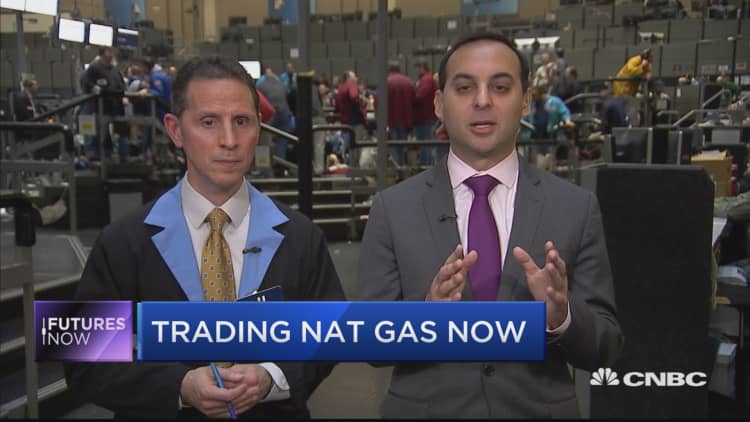Falling natural gas prices would be even lower if not for a growing U.S. export market — both via pipeline to Mexico and through liquefied natural gas shipments around the world.
Warm winter weather has been hard on U.S. natural gas producers, who have watched prices do nothing but slide since the end of last year. Natural gas futures are down 22 percent since the beginning of the year, having run up in late 2016 on the expectation that winter heating demand would result in much more gas coming out of storage.

"I think a lot of the lack of winter has been priced in," said Gene McGillian, manager market research at Tradition Energy. On Thursday, natural gas futures for March fell about 2.4 percent to $2.85 per million Btus, after the latest weekly government data showed a draw down of 114 billion cubic feet, less than expected.
But on the plus side, the gas in storage in the U.S. was 2.4 trillion cubic last week, 303 bcf less than last year at this time. However, it's still 87 bcf — or about 3.5 percent — above the five-year average of 2,358 Bcf.
"The positive spin today is the growing exports, and there's a higher level of natural gas usage intensity," said John Kilduff of Again Capital. "They [utilities] really shifted away from coal in a big way ... that's showing up in the base load demand for natural gas, and thermal coal shipments are down."
Kilduff said he expects to see a pickup in U.S. demand, once summer approaches and air conditioning use rises.
"I'm looking for it in the short-term to get back down to $2.60 depending on how things look. I'm tempted to get long down there. I do think when the summer heat comes, it will be intense enough to get us back on the upside above $3, $3.50," he said.
While relatively small, the pickup in export demand also coincides with slightly less production than at the same time a year ago. According to Genscape, U.S. natural gas production for February so far is relatively strong at 71.3 billion cubic feet per day, down 1.43 bcf/d from last year.
"We are expecting increased demand from the export sector and also increased industrial demand this year, and the export LNG and Mexican pipeline are basically the two drivers. Industrial demand is only expected to be up a couple hundred bcfs," said McGillian.
According to U.S. government data, gas pipeline shipments to Mexico reached 4.2 billion cubic feet per day already this year, up from 2.9 bcf/d in 2015.
New cross-border pipeline capacity of 7 billion cubic feet per day is expected to come on line by 2020 between Texas and Mexico, according to Citigroup. That would be on top of the current capacity of 6 to 7 billion cubic feet per day. Energy Transfer Partners, builder of the controversial in North Dakota, had approval from the Obama administration to build two pipelines to take gas from Texas to Mexico. President Donald Trump's pick to head the Energy Department, Rick Perry, had been on the board of Energy Transfer Partners.
"This is all new. Last year for LNG, we didn't export liquefied natural gas, and Mexico pipeline natural gas, you go back five years and it was very small," said McGillian.
The Energy Information Administration said Mexico is adding more electrical utility capacity and will be increasing new gas-fired capacity by 14.7 gigawatts by 2020. There will also be another 15.9 gigawatts of natural gas capacity added through 2029, as Mexico replaces coal and fuel oil fired capacity with natural gas.
As for LNG, the U.S. currently has two operating trains and Cheniere Energy is adding a third later this year and more will follow. McGillian said Cheniere shipments have gone around the world. According to government data, Chile, then Mexico took the largest amounts of LNG in January, followed by India, Argentina and China.
Another shift in the gas market could come just because prices have fallen. "We're reaching levels where it's uneconomic to run coal plants and that should pick up gas demand," said McGillian.
McGillian said natural gas begins to look attractive to plants fired by coal when gas falls under $3.
The U.S. is still a net importer of natural gas, mostly from Canada, but that should change as exports grow.


